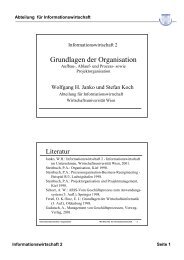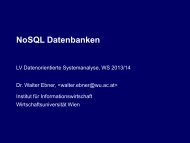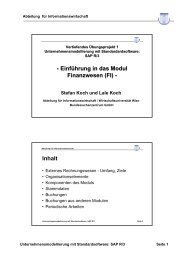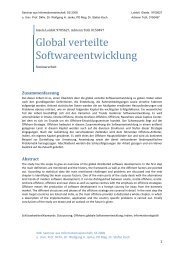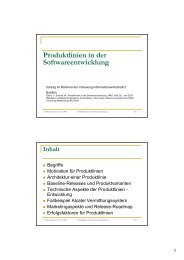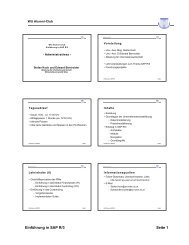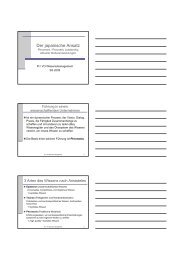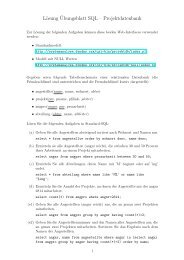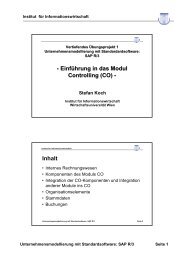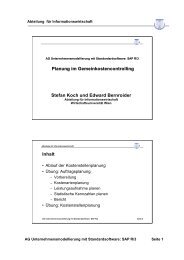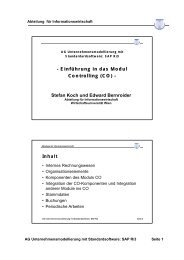A systematic approach to quality function deployment with a full ...
A systematic approach to quality function deployment with a full ...
A systematic approach to quality function deployment with a full ...
Create successful ePaper yourself
Turn your PDF publications into a flip-book with our unique Google optimized e-Paper software.
2.3. Scales andfuzziness<br />
L.-K. Chan, M.-L. Wu / Omega 33 (2005) 119 – 139 123<br />
As summarized in Section 2.1, there are many scales used in the HOQ process <strong>to</strong> measure di erent concepts. For<br />
example, it is common <strong>to</strong> use scale (1) <strong>to</strong> measure the correlation between each pair of WHATs or HOWs, scale (6) <strong>to</strong><br />
measure the relationship between each WHAT and each HOW, scale (2) <strong>to</strong> measure the relative importance of WHATs,<br />
and scale (4) <strong>to</strong> measure the companies’ current and goal performance in terms of WHATs. But there is not a rule as<br />
<strong>to</strong> which element must or should be measured by a designated scale and, in fact, di erent users may use di erent scales<br />
<strong>to</strong> measure the same concept. For example, while many authors adopt scale (2) <strong>to</strong> measure the importance of WHATs,<br />
some people prefer <strong>to</strong> use scale (3) for the same purpose.<br />
On the other hand, it is well recognized that people’s assessments of concepts are always subjective and thus imprecise,<br />
and the linguistic terms people use <strong>to</strong> express their judgements are vague in nature. Using objective, de nite and precise<br />
numbers <strong>to</strong> represent linguistic assessments are, although widely adopted, not very reasonable. A more rational <strong>approach</strong><br />
is <strong>to</strong> assign fuzzy numbers <strong>to</strong> linguistic assessments so that their vagueness can be captured. For example, rather than<br />
using numbers 1 and 5 <strong>to</strong> represent “very low” and “very high” importance in scale (2), we may assign symmetrical<br />
triangular fuzzy numbers (STFNs) such as [0.5,1.5] and [4.5,5.5] <strong>to</strong> these two linguistic assessments <strong>to</strong> express their<br />
vagueness. Here an STFN, in the form of [a, c], is a special fuzzy set representing a fuzzy concept “approximately b”<br />
where b =(a + c)=2 (see Appendix for a brief account of fuzzy set and STFN).<br />
To operate the HOQ process and make relevant computations comparable, it is necessary <strong>to</strong> unify the various scales used<br />
in HOQ. We propose a few 9-point 1-<strong>to</strong>-9 scales <strong>to</strong> measure the respective concepts in our proposed HOQ model. These<br />
scales can be represented by either conventional numbers or STFNs according <strong>to</strong> practical requirements. The rationale of<br />
adopting such 1-<strong>to</strong>-9 rating scales is proved by the many tests made by Saaty [17]. On the other hand, since 5-point scale<br />
is simple and easy <strong>to</strong> use and also includes enough information people provide on the attributes measured (Refs. [18–20]),<br />
we suggest that for each of the following 9-point scales proposed, a 5-point subscale 1-3-5-7-9 (or corresponding STFNs<br />
[0,2]-[2,4]-[4,6]-[6,8]-[8,10]) be used as much as possible. Only when compromises must be made or some uncertainty<br />
exists, the numbers 2, 4, 6, 8 (or corresponding STFNs [1,3], [3,5], [5,7], [7,9]) are adopted. These suggested scales are:<br />
• For measuring the relative importance of WHATs:<br />
• For measuring the companies’ current and goal performance in terms of WHATs:<br />
• For measuring the relationship between each WHAT and each HOW:<br />
3. Descriptions of the HOQ model<br />
According <strong>to</strong> the above preparations, our proposed 9-step HOQ model (Fig. 1) can be described as follows. These<br />
descriptions, both qualitative and quantitative, are based on the ideas from Refs. [1–9,13–15].<br />
Step 1. Identify cus<strong>to</strong>mers and collect their needs (WHATs): The producing company should know who are the<br />
cus<strong>to</strong>mers for the product concerned. There are generally three types of cus<strong>to</strong>mers, internal cus<strong>to</strong>mers such as shareholders,<br />
managers and employees, intermediate cus<strong>to</strong>mers such as wholesale people and retailers, and ultimate cus<strong>to</strong>mers such as<br />
recipients of service, purchasers, institutional purchasers. Usually the main focus is on the ultimate cus<strong>to</strong>mers who could<br />
be identi ed through previous information and marketing research.<br />
(8)<br />
(9)<br />
(10)



